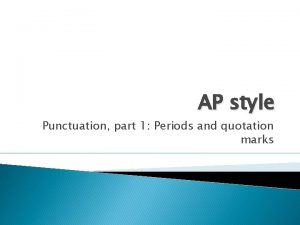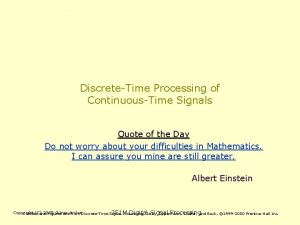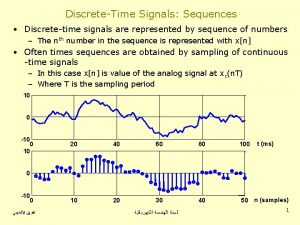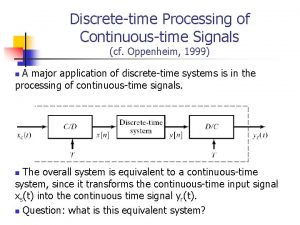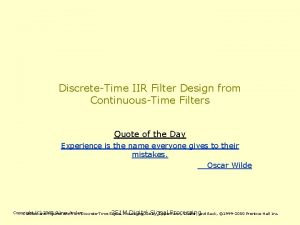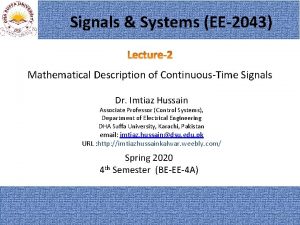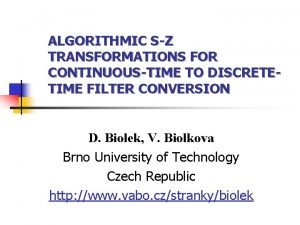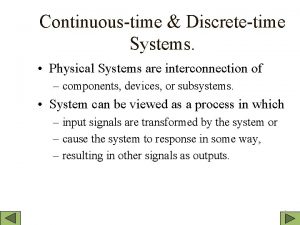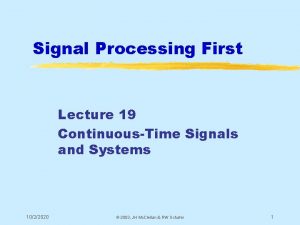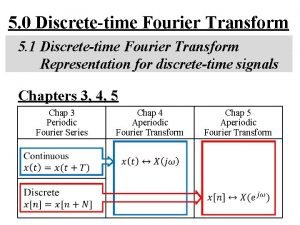DiscreteTime Processing of ContinuousTime Signals Quote of the










- Slides: 10

Discrete-Time Processing of Continuous-Time Signals Quote of the Day Do not worry about your difficulties in Mathematics. I can assure you mine are still greater. Albert Einstein Copyright (C) 2005 Güner 351 M Digital 2 e. Signal Processing Content and Figures are. Arslan from Discrete-Time Signal Processing, by Oppenheim, Shafer, and Buck, © 1999 -2000 Prentice Hall Inc.

Reconstruction of Bandlimited Signal From Samples • Sampling can be viewed as modulating with impulse train • If Sampling Theorem is satisfied – The original continuous-time signal can be recovered – By filtering sampled signal with an ideal low-pass filter (LPF) • Impulse-train modulated signal • Pass through LPF with impulse response hr(t) to reconstruct x[n] Copyright (C) 2005 Güner Arslan Convert from sequence to impulse train Ideal reconstruction filter Hr(j ) 351 M Digital Signal Processing xr(t) 2

Ideal Reconstruction Filter • Ideal LPC with cut of frequency of c= /T or fc=2/T Copyright (C) 2005 Güner Arslan 351 M Digital Signal Processing 3

Reconstructed Signal sinc function is 1 at t=0 sinc function is 0 at n. T Copyright (C) 2005 Güner Arslan 351 M Digital Signal Processing 4

Discrete-Time Processing of Continuous-Time Signals xc(t) Discrete. Time System C/D D/C yr(t) • Overall system is equivalent to a continuous-time system – Input and output is continuous-time • The continuous-time system depends on – Discrete-time system – Sampling rate • We’re interested in the equivalent frequency response – First step is the relation between xc(t) and x[n] – Next between y[n] and x[n] – Finally between yr(t) and y[n] Copyright (C) 2005 Güner Arslan 351 M Digital Signal Processing 5

Effective Frequency Response • Input continuous-time to discrete-time • Assume a discrete-time LTI system • Output discrete-time to continuous-time • Output frequency response • Effective Frequency Response Copyright (C) 2005 Güner Arslan 351 M Digital Signal Processing 6

Example • Ideal low-pass filter implemented as a discrete-time system Continuous-time input signal Sampled continuoustime input signal Apply discrete-time LPF Copyright (C) 2005 Güner Arslan 351 M Digital Signal Processing 7

Example Continued Signal after discretetime LPF is applied Application of reconstruction filter Output continuoustime signal after reconstruction Copyright (C) 2005 Güner Arslan 351 M Digital Signal Processing 8

Impulse Invariance • Given a continuous-time system Hc(j ) – how to choose discrete-time system response H(ej ) – so that effective response of discrete-time system Heff(j )=Hc(j ) • Answer: • Condition: • Given these conditions the discrete-time impulse response can be written in terms of continuous-time impulse response as • Resulting system is the impulse-invariant version of the continuous-time system Copyright (C) 2005 Güner Arslan 351 M Digital Signal Processing 9

Example: Impulse Invariance • Ideal low-pass discrete-time filter by impulse invariance • The impulse response of continuous-time system is • Obtain discrete-time impulse response via impulse invariance • The frequency response of the discrete-time system is Copyright (C) 2005 Güner Arslan 351 M Digital Signal Processing 10
 Animals and human language chapter 2
Animals and human language chapter 2 Communicative signals and informative signals
Communicative signals and informative signals Communicative and informative signals
Communicative and informative signals Ap style quote punctuation
Ap style quote punctuation Dialogue quote vs flow quote
Dialogue quote vs flow quote Integrating quotes
Integrating quotes In text citation 2 authors
In text citation 2 authors How to quote a quote apa
How to quote a quote apa Discrete time processing of continuous time signals
Discrete time processing of continuous time signals Histogram processing in digital image processing
Histogram processing in digital image processing Image enhancement by point processing
Image enhancement by point processing



